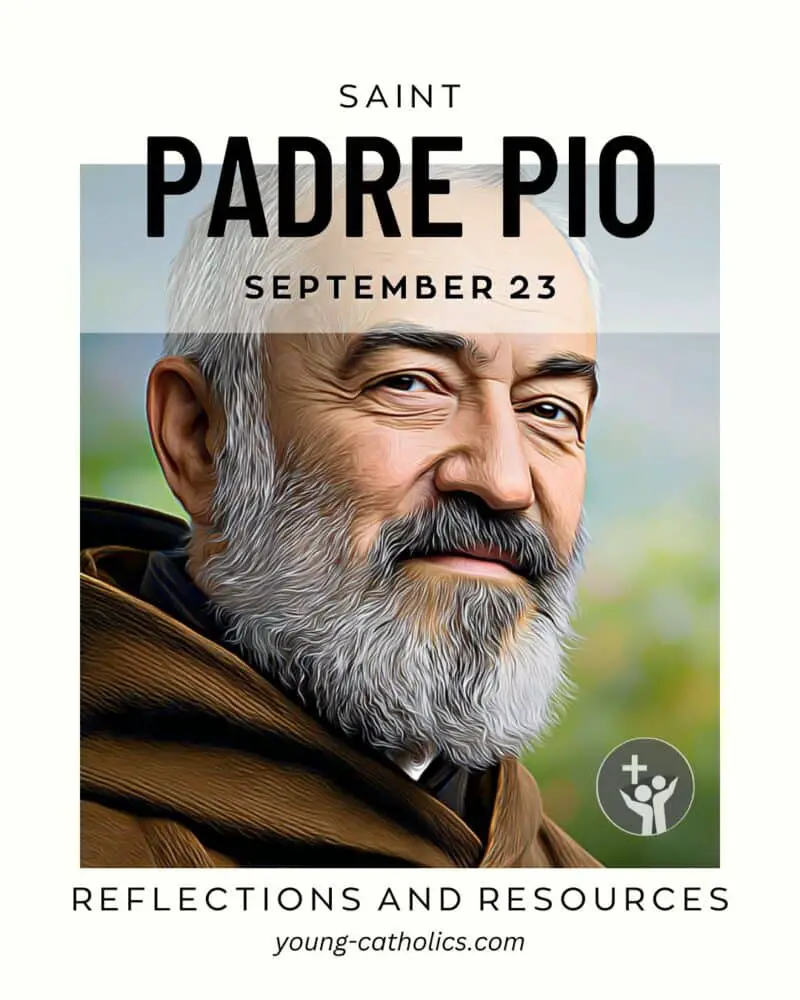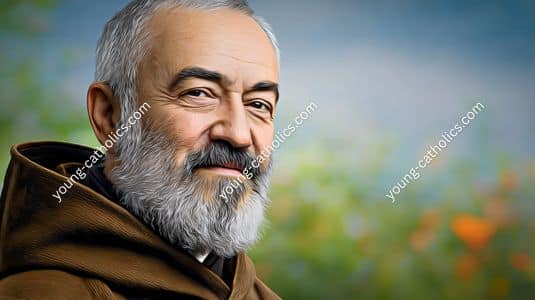Saint Padre Pio
Feast Day: September 23

Saint Padre Pio was a humble Capuchin friar from Italy. He was born in 1887 and lived most of his life in the small town of San Giovanni Rotondo. As a child, he felt called to follow Jesus. He entered the Capuchin order when he was just 15 years old.
Padre Pio became well-known for his deep prayer life and love for Jesus. People came to him for help because they believed he had special gifts. He received the stigmata, the wounds of Christ, and many people thought this was a sign of his holiness. He spent hours each day hearing confessions and helping people return to God.
Despite his gifts, Padre Pio faced many trials. Some people doubted his holiness, and even the Church investigated him. But Padre Pio stayed faithful and continued his work. He always trusted in God and prayed for others.
After his death in 1968, Padre Pio was remembered for his love of God and service to others. Many people pray to him for help today. He was canonized in 2002 by Pope John Paul II, and his life continues to inspire millions.
A Boy with a Special Calling
Saint Padre Pio was born as Francesco Forgione on May 25, 1887, in a small town called Pietrelcina, Italy. His parents were poor farmers, and they worked hard to support their family. Even as a young boy, Francesco showed signs that he was different. He loved to pray and spent much of his time in church. He would often say he wanted to become a priest when he grew up.
Francesco’s family was very religious. They prayed together often and went to Mass regularly. His mother noticed that he had a deep love for God from a very early age. When he was only five years old, he made a promise to dedicate his life to Jesus. He also said he sometimes saw visions of Jesus and Mary.
His parents were supportive of his desire to become a priest. When he was 15, Francesco joined the Capuchin friars. This was the start of his journey to become Padre Pio, a man who would later touch the lives of many people around the world.
Answering the Call
At the age of 15, Francesco Forgione entered the Capuchin friary. He took the name “Pio” in honor of Saint Pius V. The Capuchins are a branch of the Franciscans, known for their simple lifestyle and dedication to serving others. Padre Pio felt at home with them because he always wanted to live humbly and close to God.
As a friar, Padre Pio focused on prayer and study. He worked hard to grow in his faith and prepare for the priesthood. But his journey was not easy. He struggled with poor health, which forced him to leave the friary a few times to rest at home. Despite these challenges, he never gave up.
On August 10, 1910, Padre Pio was ordained a priest. He was only 23 years old. His health was still fragile, but he served with a deep sense of purpose. Padre Pio celebrated Mass with great devotion and spent much time in prayer. This was just the beginning of his long life of service as a Capuchin friar.
The Marks of Christ
In 1918, Padre Pio received the stigmata, the wounds of Christ. These wounds appeared on his hands, feet, and side, just like where Jesus was wounded during the Crucifixion. This happened while he was praying in front of a crucifix in his friary.
The stigmata caused Padre Pio pain, but he accepted it as a part of sharing in Christ’s suffering. Many people saw the wounds as a sign of his holiness. Doctors and church officials examined him, but they couldn’t explain how the wounds came about.
Word spread quickly about Padre Pio’s stigmata, and people began traveling to see him. Some were curious, while others were seeking healing and help. Padre Pio always remained humble and focused on prayer, never drawing attention to the wounds themselves. He kept serving others despite the pain he carried.
Extraordinary Gifts
Padre Pio was known for many miracles and spiritual gifts. One of his most famous gifts was the ability to heal. Many people who came to him sick or suffering left feeling better. Some claimed to be completely healed after meeting him or receiving his prayers. These healings drew even more people to Padre Pio.
Another special gift was bilocation. This means that Padre Pio was said to be seen in two places at once. There are stories of him being in his friary and also appearing to help someone miles away at the same time.
He also had the ability to read souls. When people came to confession, Padre Pio would sometimes tell them their sins before they spoke. This helped them repent fully and turn back to God.
These miracles made Padre Pio famous, but he always gave credit to God for any good that happened. He never wanted attention for himself, only to help people come closer to Jesus.
Facing Doubts and Hardships
Despite his gifts, Padre Pio faced many challenges. Some people, including church officials, doubted the authenticity of his stigmata and miracles. They questioned if the wounds were real or if he was somehow faking them. This brought suspicion and investigations into his life.
At one point, the Church even restricted Padre Pio’s activities. He was not allowed to celebrate public Mass or hear confessions. These restrictions caused him much pain, but he remained obedient to the Church and accepted the situation with patience.
Over time, more investigations took place, and eventually, the Church lifted the restrictions. Padre Pio was allowed to continue his ministry, and his reputation grew stronger. He never spoke badly about those who doubted him, and he continued to pray for everyone, even those who caused him suffering.
A Life Centered on the Sacraments
Padre Pio had a deep love for the sacraments, especially confession and the Eucharist. He spent many hours each day hearing confessions. People would wait in long lines just to have him hear their sins and offer them forgiveness. Padre Pio believed confession was important for healing the soul and bringing people closer to God.
The Eucharist was also central to his life. He celebrated Mass with great reverence and care, often spending hours in prayer before and after the service. Padre Pio saw the Eucharist as the source of strength for his ministry and encouraged others to receive it as often as they could. Through these sacraments, Padre Pio led many people back to a stronger faith.
Simple Words of Wisdom
Padre Pio gave clear and simple advice to those who came to him. One of his most famous sayings was, “Pray, hope, and don’t worry.” He encouraged people to trust God in all things and not be anxious. He reminded them that God was in control, even in difficult times.
He also taught the importance of prayer. Padre Pio urged people to pray daily and to stay close to Jesus through the Rosary. He believed that prayer was the key to growing in faith and overcoming struggles.
Another message he shared was to accept suffering with patience. Padre Pio often said that suffering could bring us closer to Jesus, who suffered for us. He encouraged people to unite their pain with Christ’s suffering on the cross.
Lastly, he reminded people to love one another. Padre Pio stressed the need for kindness, forgiveness, and helping those in need. His teachings were simple but had a lasting impact on those who followed his advice.
A Saint for Our Time
After Padre Pio’s death in 1968, people continued to honor his memory and share stories of his life. Many believed he had helped them through his prayers, even after his passing. Over the years, his reputation for holiness spread across the world.
The process of canonization began when Saint Pope John Paul II declared Padre Pio “Venerable” in 1997. This was the first official step toward sainthood. In 1999, after the Church confirmed a miracle through his intercession, he was beatified. Finally, in 2002, Saint Pope John Paul II canonized him, declaring him Saint Padre Pio.
Saint Padre Pio’s feast day is celebrated on September 23, the day of his death. This is the day the Church honors his life and legacy. Many people celebrate his feast by attending Mass, praying the Rosary, or reflecting on his teachings.
Today, Saint Padre Pio is a patron of civil defense volunteers, stress relief, and those who suffer from illnesses. Many people pray to him for healing or strength during difficult times. His intercession is sought by people facing physical or emotional pain.
His legacy continues in the lives of those he inspired. The hospital he founded, Casa Sollievo della Sofferenza, is still active today, offering care to the sick. His friary in San Giovanni Rotondo remains a popular pilgrimage site, visited by millions each year.
Saint Padre Pio’s message of prayer, trust in God, and accepting suffering continues to guide people today. His simple but strong faith shows how anyone can live a life close to Jesus.
Daily Mass Readings for the Memorial of Saint Pius of Pietrelcina, Priest
Readings for the Memorial may also be taken from may also be taken from the readings of the day, the Common of Pastors, or the Common of Holy Men and Women (for religious).
- First Reading – Galatians 2:19-20: Paul says he’s dead to the law but alive through Christ. He lives in the flesh by faith in the Son of God, who sacrificed himself for him.
- Responsorial Psalm – Psalm 128: Those who fear the LORD and walk in his ways are blessed. They will enjoy the fruits of their labor, have a fruitful family life, and witness the prosperity of Jerusalem.
- Gospel – Matthew 16:24-27: To follow me, one must deny themselves and bear their own cross. Saving one’s life means losing it for my sake. Gaining worldly possessions isn’t worth forfeiting one’s life. Judgment comes eventually.
Homilies and Reflections
Walking in Padre Pio’s Footsteps
Saint Padre Pio’s life shows us the power of simple faith. He was not famous for great works or writing many books. He became holy by trusting in God and serving people quietly. We can learn from his example that holiness is found in daily actions—prayer, kindness, and patience. He reminds us that we do not need to be important in the world’s eyes to be close to God.
Padre Pio also teaches us the value of suffering. He experienced pain through the stigmata and other challenges. Instead of complaining, he offered his suffering to God. This shows us how we can handle our own difficulties. Whether it’s illness, stress, or personal struggles, we can unite our pain with Christ’s and find peace.
His love for the sacraments, especially confession and the Eucharist, encourages us to seek God’s grace regularly. Padre Pio understood that these were gifts from God that helped him grow in holiness. He spent hours in confession and prayer, showing us the importance of staying connected to God in our own lives.
Finally, Padre Pio’s humility and obedience remind us to trust God even when we face doubts or challenges. He was misunderstood and questioned by others, yet he never lost faith. His life encourages us to trust God’s plan for us, even when things are difficult or confusing.
Reflection Questions
- How can I be more faithful in prayer like Padre Pio?
- How can I offer my sufferings to God instead of complaining?
- Do I make the sacraments a regular part of my life? How can I grow in this area?
Suffering with Purpose
Saint Padre Pio lived with deep pain, but he never let it go to waste. He brought that suffering to God, and through it, became a source of healing for countless others. His life reminds us: suffering isn’t meaningless when it’s united with Christ.
This prayer is a way to do that—to trust God with your pain and ask for healing in body, mind, and soul. And maybe it’s also time to share this prayer with someone else who’s hurting. Like Padre Pio, your suffering can become a doorway to grace—for you and for others.
The Fascinating and Frightening Padre Pio
This reflection discusses the complex character of Saint Padre Pio, describing him as both fascinating and frightening. Known for his stigmata and supernatural gifts like bilocation and healing, he was a deeply spiritual but also stern figure. While drawing attention for his miraculous phenomena, he was equally committed to the sacraments, particularly confession, where he spent many hours each day.
He embodies the paradoxes of Christian life, being both a mystic and a moralist, which makes him an intriguing yet challenging saint to understand and follow.
Social Media Graphics and Bulletin Artwork
A Heart for God: Saint Padre Pio

This warm and lifelike poster of Saint Padre Pio captures his gentle strength and deep faith. His serene expression and Franciscan habit make it an inspiring reminder of prayer, humility, and trust in God. Perfect for any Christian home, church, or prayer room.
Click on the image for more information on how to get the full sized artwork.
Paid subscribers may download a large copy this digital artwork without watermarks, suitable for use in bulletins, social media, newsletters, etc., free of charge by clicking here. You must be logged in as a paid subscriber to access the file.
Only current paid subscribers have the rights to use the artwork.
Questions and Answers
Who was Saint Padre Pio?
He was an Italian Capuchin friar and priest known for his deep faith, the stigmata, and many miracles. He lived from 1887 to 1968.
What is Saint Padre Pio famous for?
He is famous for the stigmata, the wounds of Christ, which he bore on his body. He is also known for healing, bilocation, and reading souls.
What is the stigmata?
The stigmata are the wounds of Christ’s Crucifixion, which appeared on Saint Padre Pio’s hands, feet, and side. These wounds caused him pain but did not heal.
When is Saint Padre Pio’s feast day?
His feast day is on September 23, the day of his death.
What miracles are associated with Saint Padre Pio?
He is associated with many miracles, including healing the sick, bilocation, and reading souls during confession.
Why was Saint Padre Pio investigated by the Church?
He was investigated by the Church because some people doubted the authenticity of his stigmata and miracles. The Church wanted to be sure his experiences were real.
How did Saint Padre Pio help people in confession?
He could often tell people their sins before they confessed. He helped them repent fully and return to God.
Why is Saint Padre Pio also known as Saint Pius of Pietrelcina?
He is also called Saint Pius of Pietrelcina because “Pio” is the Italian form of the name “Pius.” When he became a Capuchin friar, he took the name “Pio” in honor of Pope Saint Pius V. “Pietrelcina” refers to his birthplace in Italy. So, his full religious name is Saint Pius (Padre Pio) of Pietrelcina.
What is Saint Padre Pio the patron saint of?
He is the patron saint of civil defense volunteers, stress relief, and those suffering from illnesses.
How can I follow the example of Saint Padre Pio?
You can follow his example by praying daily, trusting God in all things, going to confession often, and accepting suffering with patience.
What are the Mass readings for the Memorial of Saint Pius of Pietrelcina, Priest?
Readings for the Memorial may also be taken from may also be taken from the readings of the day, the Common of Pastors, or the Common of Holy Men and Women.
First Reading – Galatians 2:19-20: Living Through Christ
Responsorial Psalm – Psalm 128: Blessings for the God-Fearing
Gospel – Matthew 16:24-27: The Cost of Following Jesus
An Inspiring Mystic
Saint Padre Pio was born as Francesco Forgione in Italy in 1887. From a young age, he showed a deep love for God and a desire to become a priest. At 15, he joined the Capuchin friars and took the name Pio. Throughout his life, he was known for his deep prayer life, his stigmata, and many miracles. People came from all over to see him and ask for his prayers.
Padre Pio spent hours hearing confessions and offering spiritual guidance. He had the ability to heal the sick, bilocate, and even read souls during confession. Though some doubted him and the Church investigated his stigmata, Padre Pio remained humble and obedient. His love for the Eucharist and confession inspired many to grow in their faith.
He passed away in 1968, and the Church canonized him in 2002. His feast day is celebrated on September 23, and he is the patron saint of those suffering from illness and stress. His life continues to inspire millions to this day.
Your Turn
Saint Padre Pio’s life is full of lessons for all of us. His trust in God, even in times of suffering, can help us grow in faith. Learn more about his life, his love for the sacraments, and his many miracles. Read about how he helped others and how his simple faith can guide you.
Share your thoughts or experiences about Saint Padre Pio in the comments section. Let’s continue the conversation and reflect on how we can follow his example.



Leave a Reply